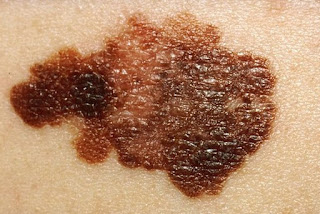Melanoma: Classifications of Melanoma
Melanoma: Classifications of Melanoma
Let me be
frank, cancer is frightening. It doesn’t take a wise guy to know that. But,
often when people hear their physicians’ diagnosis, in fear we shut down and
don’t listen to anything else. In this blog entry I will being going a little deeper
in melanoma and give some specifics about the classification of melanoma.
Melanoma
classifications are all based on the characteristics of the lesion, rather than
being based on how the cancer has progressed. The most common classification of
melanoma is the Superficial Spreading Melanoma, as seventy percent of diagnosed
melanoma being of this classification. This melanoma is common in people in
their youth and has a wide variation of coloration with tan, brown, black, red,
blue or white. As the name may suggest this melanoma typically grows along the
top layer of the skin for a while before it gains depth. What may be the deadliest
fact about this melanoma is that it can develop anywhere in the body, even
places you cannot easily check, and it can occur in a previously benign mole. (Skin Cancer
Foundation)
Lentigo
maligna, is another classification of melanoma and is most common in the
elderly. This melanoma arises on mostly on damaged skin, such as the face,
ears, arms, and upper trunk. Like superficial spreading melanoma, lentigo
maligna remains on the skins surface for a while and appears as flat or mildly
elevated. The coloration is different though as it usually appears as black or
dark brown. (Skin Cancer Foundation)
Acral
lentiginous melanoma, is another melanoma that starts out on the skins surface,
before spreading deeply. What makes this classification unique for others is
that it starts under the nails, soles of your feet, palms of your hands. It
usually appears black or brown, and more common in African Americans, and
people of Asian descent. Due to the odd places this melanoma starts it has more
time to progress than the classifications earlier described. (Skin Cancer Foundation)
Nodular
melanoma is usually more invasive than the other classifications as it is
recognized when a bump or nodule appears. The coloration of this melanoma is
usually black but has been found with blue, grey, white, tan, or red skin
tones. The more frequent locations are
the trunk, legs, scalp, and arms. This melanoma is usually the most aggressive
and found in ten to fifteen percent of cases. (Skin Cancer Foundation)
Last but not the least, Ocular Melanoma. Ocular melanoma or uveal
melanoma, just like the other melanoma results from the melanocytes. What makes
this melanoma different is that it’s of the eyes rather than the skin. This
melanoma behaves differently then the melanoma found in your skin and is known
to be a silent killer. The cause of this melanoma is unknown as it is not from
UV light exposure. Due to its lack of early warning signs and location, the
only way it can be detected is through an ophthalmologist examination. The
Ocular Melanoma Foundation describes the outcome of Ocular Melanoma is not
detected early “universally fatal.” “This 50% mortality rate is unchanged
despite treatment advances in treating the primary eye tumor” (Occular
Melanoma Foundation)
Works Cited
Occular Melanoma Foundation. Basics of OM.
2017. http://www.ocularmelanoma.org/basics. 15 February 2018.
Skin Cancer Foundation. Types of Melanoma.
2018.
https://www.skincancer.org/skin-cancer-information/melanoma/types-of-melanoma.
15 February 2018.









Comments
Post a Comment